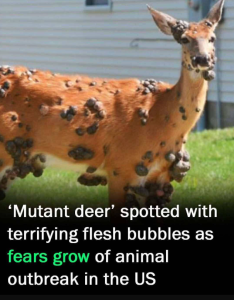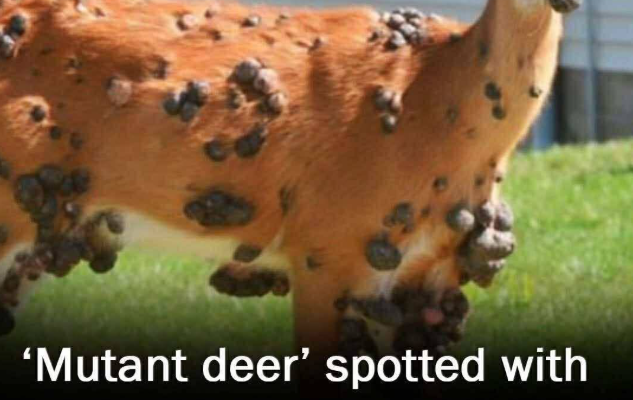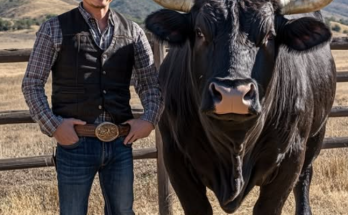🦌 The Rise of the “Mutant Deer” Phenomenon
In recent months, social media platforms have been flooded with eerie images of deer covered in fleshy, bubble-like growths. These deformities—ranging from small nodules to football-sized tumors—have been spotted in states like New York, Pennsylvania, and Wisconsin. The sight of these animals has stirred public anxiety, with some likening the appearance to scenes from apocalyptic films or zombie thrillers.
But what’s really going on?
🧬 What Is Deer Cutaneous Fibroma?
The condition behind these grotesque growths is known as deer cutaneous fibroma, or more colloquially, deer warts. It’s caused by a species-specific papillomavirus, meaning it affects only deer and cannot be transmitted to humans or other animals.
Characteristics:
- Wart-like lesions on the skin
- Commonly found on the head, neck, and legs
- Can be gray, black, or fleshy in appearance
- Typically hairless and may appear fissured or lumpy
These growths are usually benign and often resolve on their own. However, in severe cases, they can impair the deer’s ability to eat, move, or see—leading wildlife officials to consider euthanasia as a humane option.
🦟 How the Virus Spreads
The virus is primarily transmitted through biting insects such as mosquitoes and ticks. These pests carry the virus from infected deer to healthy ones, especially during warmer months when insect activity peaks.
Other transmission methods include:
- Direct contact with infected surfaces
- Shared feeding areas or rubbing posts, especially during mating season
Interestingly, male deer are more frequently affected, possibly due to their territorial behavior and physical confrontations.
🌡️ Climate Change and the Surge in Cases
Experts suggest that climate change may be contributing to the rise in cases. Warmer temperatures create ideal breeding conditions for mosquitoes and ticks, increasing the likelihood of viral transmission.
Dr. Omer Awan from the University of Maryland School of Medicine noted that diseases once confined to specific regions are now appearing in new areas due to shifting climate patterns. This includes not only deer fibroma but also other wildlife diseases like:
- Shope papilloma virus in rabbits (causing horn-like growths)
- Squirrel fibromatosis, a poxvirus-induced condition
🧠 Public Reaction and Outbreak Fears
The term “mutant deer” has captured public imagination, fueling fears of a broader outbreak. Viral posts on platforms like Reddit and X (formerly Twitter) show deer with grotesque growths wandering through suburban backyards. Some users speculated wildly—suggesting gunshot wounds, tumors, or even prion diseases.
While the images are disturbing, wildlife experts have urged calm. The virus is not new, and it poses no threat to humans or pets. The growths are unsightly but typically harmless, and most deer recover without intervention.
🧪 Scientific Context: Papillomaviruses
Papillomaviruses are a large family of viruses that infect skin and mucous membranes. In humans, they cause conditions like:
- Common warts
- Plantar warts
- Genital warts
- Certain cancers (e.g., cervical, throat)
However, the deer-specific virus is adapted only to infect deer, meaning it cannot jump species due to differences in cellular receptors.
🛡️ Safety Measures for Humans
Although the virus doesn’t infect humans, experts recommend basic precautions for those living near affected areas:
| Safety Tip | Why It Matters |
|---|---|
| Use insect repellent | Reduces mosquito and tick bites |
| Avoid touching wild animals | Prevents accidental exposure to other pathogens |
| Maintain hygiene | Wash hands after outdoor activities |
| Keep surroundings clean | Discourages pest breeding |
These measures are especially important in forested or rural areas where deer populations are dense.
🐾 Impact on Wildlife and Ecosystems
While deer fibroma itself may not be catastrophic, the broader trend of mutated wildlife raises ecological concerns. The appearance of deformities in multiple species—rabbits, squirrels, and now deer—suggests a possible shift in disease dynamics.
Potential consequences include:
- Disruption of food chains
- Increased mortality in affected species
- Greater human-wildlife interaction, raising the risk of zoonotic diseases
Wildlife agencies are monitoring the situation closely, but so far, there’s no evidence of a widespread epidemic.
🧭 What Should You Do If You See an Infected Deer?
If you encounter a deer with visible growths:
- Do not approach or touch it
- Report the sighting to your local wildlife agency
- Avoid feeding or interacting with wild animals
In most cases, the deer will recover naturally. However, if the animal appears unable to eat, move, or see, officials may intervene to prevent suffering.
🧩 Debunking Myths
Let’s clear up some common misconceptions:
❌ “The virus can infect humans.”
Nope. It’s species-specific and cannot jump to people or pets.
❌ “The deer are turning into zombies.”
While the appearance is unsettling, the condition is not neurological or behavior-altering.
❌ “It’s caused by weedkiller or pollution.”
There’s no evidence linking the virus to chemical exposure. It’s a naturally occurring viral infection.
🌍 A Broader Wake-Up Call
The “mutant deer” scare is a reminder of how climate change, urban expansion, and ecosystem disruption can amplify wildlife diseases. As animals migrate into human spaces, the potential for disease transmission—whether direct or via vectors—increases.
It also highlights the power of social media in shaping public perception. A few viral images can spark nationwide panic, even when the science tells a calmer story.
🧘 Final Thoughts
The sight of deer covered in fleshy bubbles is undeniably disturbing. But beneath the sensational headlines lies a manageable, well-understood condition. Deer cutaneous fibroma is not new, not contagious to humans, and not a sign of an impending apocalypse.
Still, the phenomenon deserves attention—not because it threatens us directly, but because it reflects deeper shifts in our environment. As we navigate a changing climate and increasingly blurred boundaries between human and animal habitats, vigilance and respect for wildlife are more important than ever.
So next time you see a “mutant deer” trending online, take a breath. The real story is complex, scientific, and—thankfully—not the beginning of a zombie outbreak.

